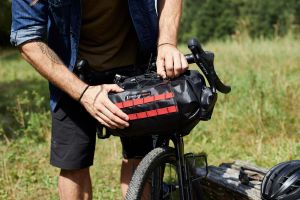Imagine you are riding along a nice straight forest road for a few kilometres and suddenly a gravel forest path opens up in front of you at the side of the road. With a gravel bike you can simply turn off. Bikes such as the STEVENS Prestige, the Gavere or the Tabor will take you quickly over the asphalt as well as quickly and safely over rougher terrain. You decide which turn you take, what you discover next. Gravel biking is no longer about how far and how fast you've gone, but only about how much fun you've had on the bike. With a gravel bike you have everything you need, even for an overnight stay.
Advantages of weight and geometry
There are several reasons for the flexibility of a gravel bike. Firstly, there is the weight. STEVENS Gravel bikes weigh only slightly more than 10 kg. No other all-round model can keep up. Thanks to the light material, you can ride quickly on the road as well as on gravel tracks and forest paths. Even if you decide to go on a bike-packing tour, all functional packing options are also designed for low weight.
On the other hand, there is the special bike geometry and the wider tires. The seating position is sporty, but comfortable enough for long discovery tours. The longer wheelbase ensures a smoother ride, especially off asphalt roads, and the comfort required for the area of use. The wide tires also contribute to this. Typical for gravel bikes are 40 mm wide tires. By the way, we have built our bikes in such a way that tyres up to 45 mm can be retrofitted if desired. The wider but still fast tires will bring you safely over uneven tracks and still provide enough pace on the road.
Gravel-optimised drivetrain for more control
And then there are the handlebars and grips as well as the component group. Gravel bikes have somewhat wider handlebars and brake levers that provide good grip. But it's not just the width of the handlebars that makes the bike easier to control on more demanding terrain. It is above all the flare. This means that the lower handlebar is wider than the upper handlebar, which also creates space for the bike-packing handlebar bag. In addition, the specially profiled grips reduce slipping in wet and muddy conditions.
The fact that Shimano last year also launched its own component group for gravel demands underlines the steep upward trend for this segment. With the GRX groupset, Shimano combines the qualities of its speed-oriented road bike groupsets and MTB groupsets designed for alpine off-road use in one component ensemble - really stable, reliable and robust as well as with a gear ratio range suitable for gravel.
Enjoyment instead of just performance: that's the difference to the Cross
So, while the differences to a road bike are supposedly easy to spot - geometry, tires, packing options - you have to look a little closer for the dividing line to cyclocross. Although cyclocross tires are also wider than those on road bikes, they are standardised by the UCI for racing use (33 mm), so they are somewhat narrower than gravel tires. The geometry and thus the riding position is also more aggressive and clearly sportier than on a gravel bike. Comfort is not the main focus of the Cross, but performance and riding efficiency.
And that's exactly what gravel biking is not all about. Sport and fun, yes, but also comfort and control. There are gravel bikes to make sure that this fits together perfectly on any surface. So everyone can become an adventurer. The next micro adventure starts right on your doorstep. Try it out!








